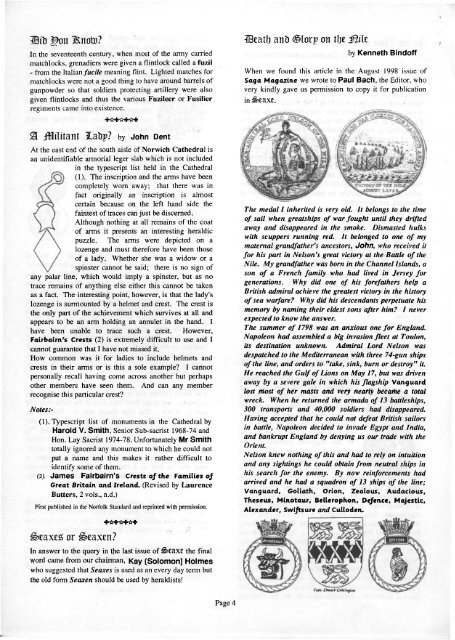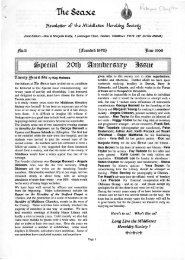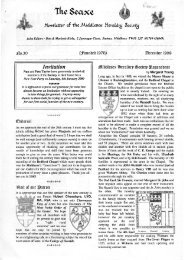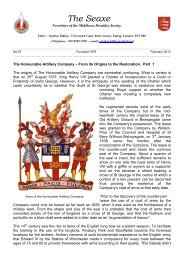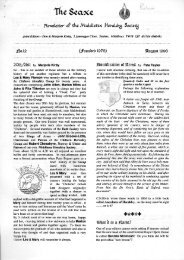The Seaxe - Middlesex Heraldry Society
The Seaxe - Middlesex Heraldry Society
The Seaxe - Middlesex Heraldry Society
Create successful ePaper yourself
Turn your PDF publications into a flip-book with our unique Google optimized e-Paper software.
Did You Know?<br />
In the seventeenth century, when most of the army carried<br />
matchlocks, grenadiers were given a flintlock called a fuzil<br />
- from the Italian fucile meaning flint. Lighted matches for<br />
matchlocks were not a good thing to have around barrels of<br />
gunpowder so that soldiers protecting artillery were also<br />
given flintlocks and thus the various Fuzileer or Fusilier<br />
regiments came into existence.<br />
A Militant Lady? by John Dent<br />
At the east end of the south aisle of Norwich Cathedral is<br />
an unidentifiable armorial ledger slab which is not included<br />
in the typescript list held in the Cathedral<br />
(1). <strong>The</strong> inscription and the arms have been<br />
completely worn away; that there was in<br />
fact originally an inscription is almost<br />
certain because on the left hand side the<br />
faintest of traces can just be discerned.<br />
Although nothing at all remains of the coat<br />
of arms it presents an interesting heraldic<br />
puzzle. <strong>The</strong> arms were depicted on a<br />
lozenge and must therefore have been those<br />
of a lady. Whether she was a widow or a<br />
spinster cannot be said; there is no sign of<br />
any palar line, which would imply a spinster, but as no<br />
trace remains of anything else either this cannot be taken<br />
as a fact. <strong>The</strong> interesting point, however, is that the lady's<br />
lozenge is surmounted by a helmet and crest. <strong>The</strong> crest is<br />
the only part of the achievement which survives at all and<br />
appears to be an arm holding an annulet in the hand. I<br />
have been unable to trace such a crest. However,<br />
Fairbairn's Crests (2) is extremely difficult to use and I<br />
cannot guarantee that I have not missed it.<br />
How common was it for ladies to include helmets and<br />
crests in their arms or is this a sole example? I cannot<br />
personally recall having come across another but perhaps<br />
other members have seen them. And can any member<br />
recognise this particular crest?<br />
Notes:-<br />
(1). Typescript list of monuments in the Cathedral by<br />
Harold V. Smith, Senior Sub-sacrist 1968-74 and<br />
Hon. Lay Sacrist 1974-78. Unfortunately Mr Smith<br />
totally ignored any monument to which he could not<br />
put a name and this makes it rather difficult to<br />
identify some of them.<br />
(2). James Fairbairn's Crests of the Families of<br />
Great Britain and Ireland. (Revised by Laurence<br />
Butters, 2 vols., n.d.)<br />
First published in the Norfolk Standard and reprinted with permission.<br />
<strong>Seaxe</strong>s or <strong>Seaxe</strong>n?<br />
In answer to the query in the last issue of <strong>Seaxe</strong> the final<br />
word came from our chairman, Kay [Solomon] Holmes<br />
who suggested that <strong>Seaxe</strong>s is used as an every day term but<br />
the old form <strong>Seaxe</strong>n should be used by heraldists!<br />
Page 4<br />
Death and Glory on the Nile<br />
by Kenneth Bindoff<br />
When we found this article in the August 1998 issue of<br />
Saga Magazine we wrote to Paul Bach, the Editor, who<br />
very kindly gave us permission to copy it for publication<br />
in <strong>Seaxe</strong>.<br />
<strong>The</strong> medal I inherited is very old. It belongs to the time<br />
of sail when great ships of war fought until they drifted<br />
away and disappeared in the smoke. Dismasted hulks<br />
with scuppers running red. It belonged to one of my<br />
maternal grandfather's ancestors, John, who received it<br />
for his part in Nelson's great victory at the Battle of the<br />
Nile. My grandfather was born in the Channel Islands, a<br />
son of a French family who had lived in Jersey for<br />
generations. Why did one of his forefathers help a<br />
British admiral achieve the greatest victory in the history<br />
of sea warfare? Why did his descendants perpetuate his<br />
memory by naming their eldest sons after him? I never<br />
expected to know the answer.<br />
<strong>The</strong> summer of 1798 was an anxious one for England.<br />
Napoleon had assembled a big invasion fleet at Toulon,<br />
its destination unknown. Admiral Lord Nelson was<br />
despatched to the Mediterranean with three 74-gun ships<br />
of the line, and orders to "take, sink, burn or destroy" it.<br />
He reached the Gulf of Lions on May 17, but was driven<br />
away by a severe gale in which his flagship Vanguard<br />
lost most of her masts and very nearly became a total<br />
wreck. When he returned the armada of 13 battleships,<br />
300 transports and 40,000 soldiers had disappeared.<br />
Having accepted that he could not defeat British sailors<br />
in battle, Napoleon decided to invade Egypt and India,<br />
and bankrupt England by denying us our trade with the<br />
Orient.<br />
Nelson knew nothing of this and had to rely on intuition<br />
and any sightings he could obtain from neutral ships in<br />
his search for the enemy. By now reinforcements had<br />
arrived and he had a squadron of 13 ships of the line;<br />
Vanguard, Goliath, Orion, Zealous, Audacious,<br />
<strong>The</strong>seus, Minotaur, Bellerophon, Defence, Majestic,<br />
Alexander, Swiftsure and Culloden.


